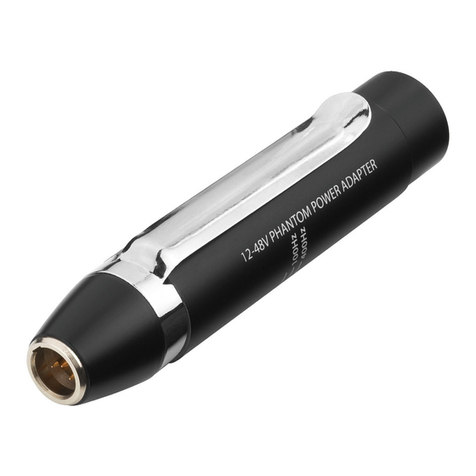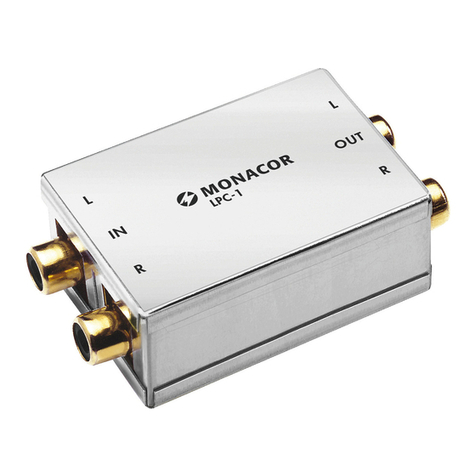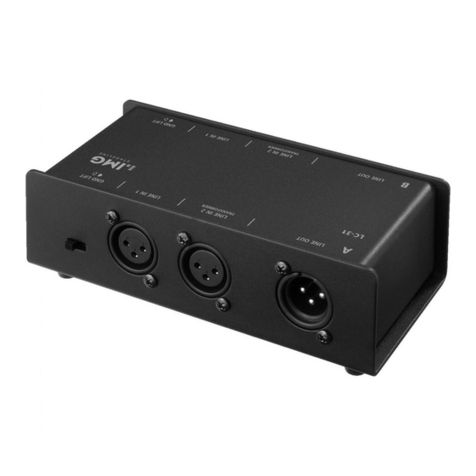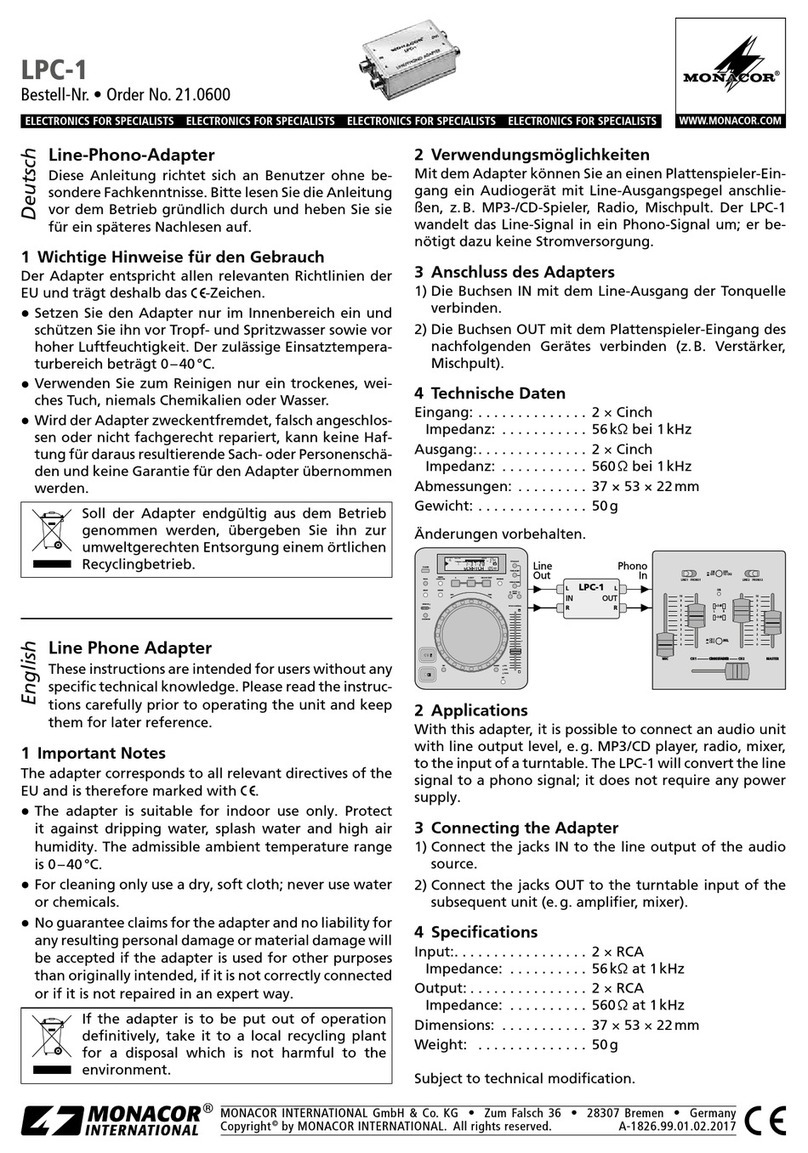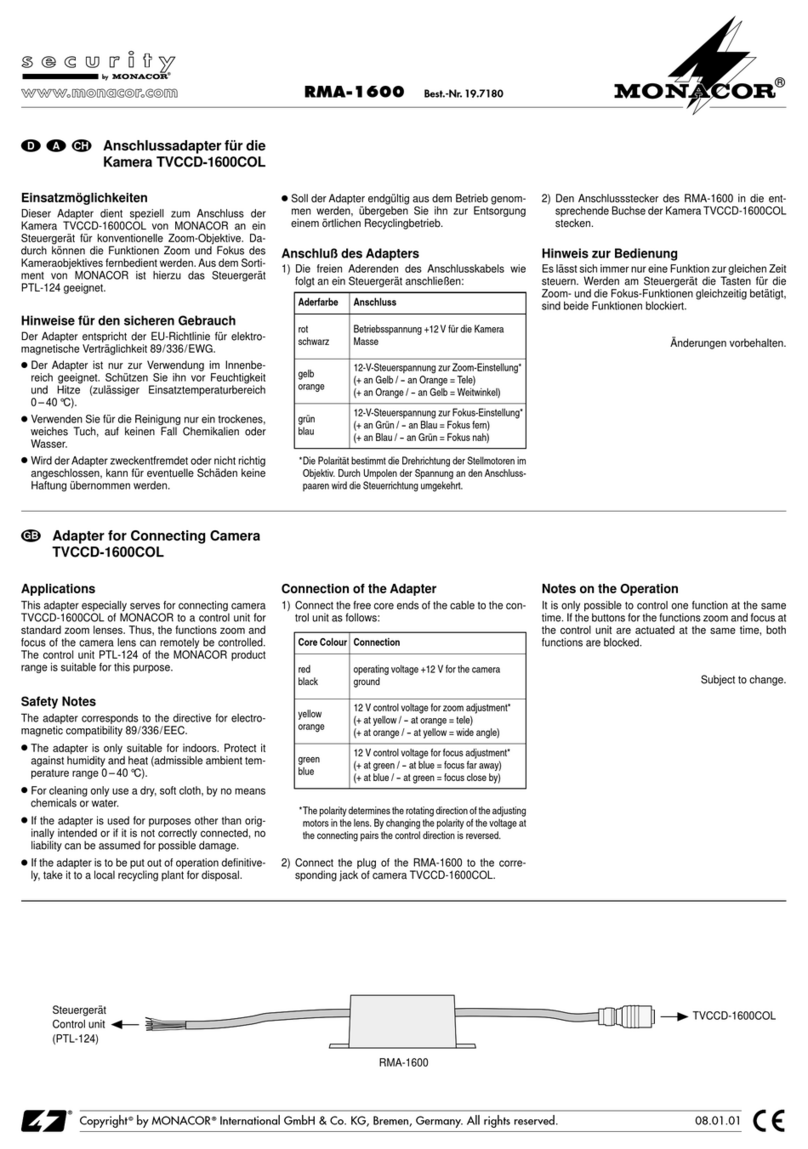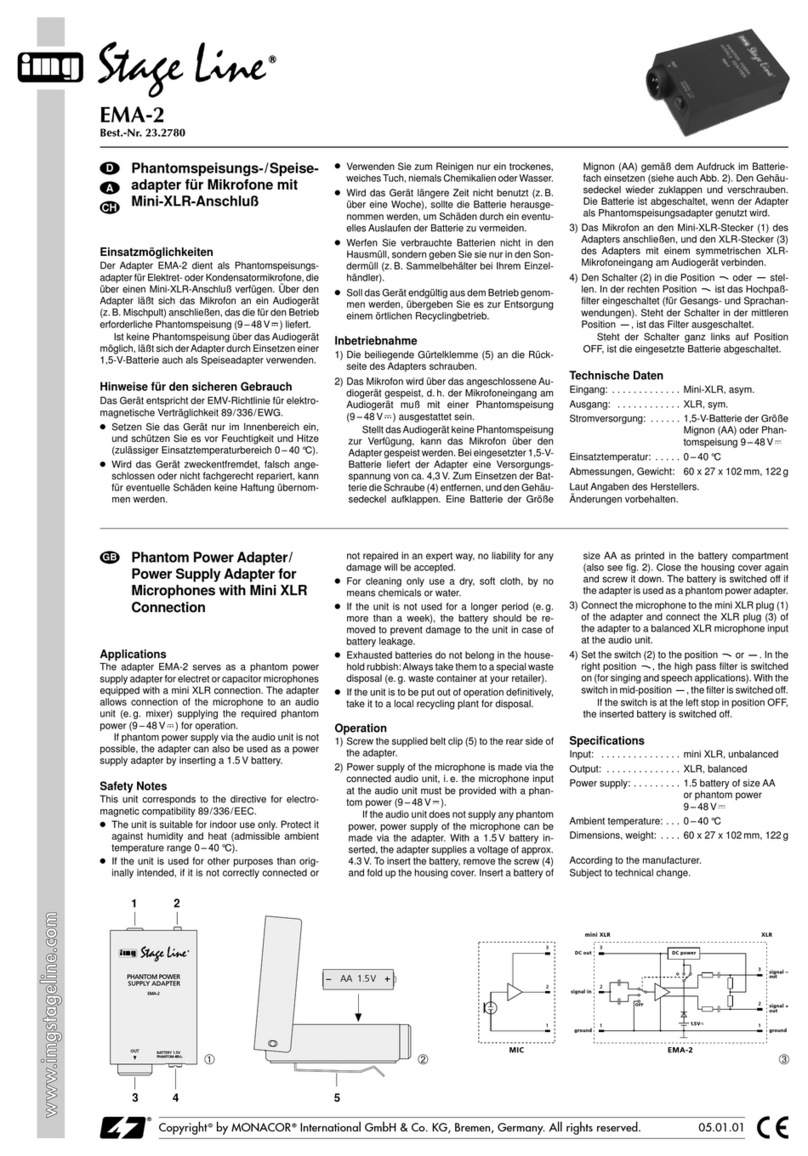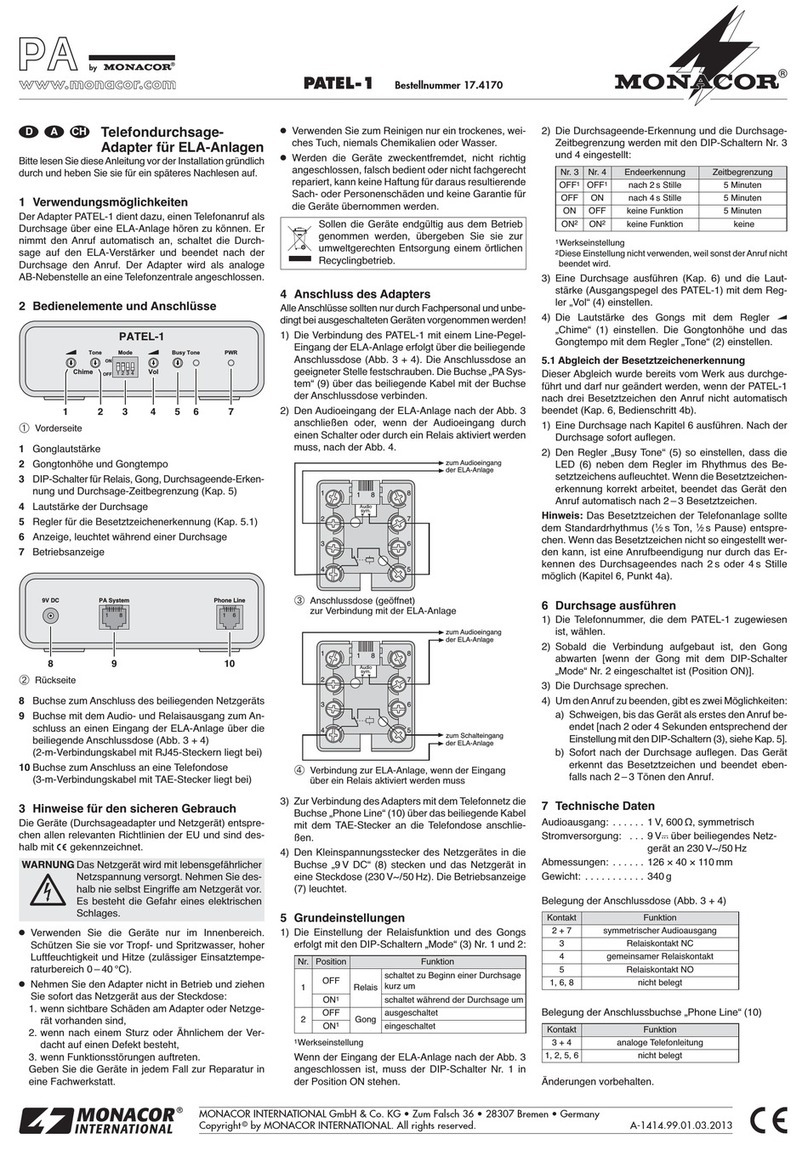
Copyright©by MONACO INTE NATIONAL GmbH & Co. KG, Bremen, Germany. All rights reserved. A-0921.99.01.12.2008
®
DM A-1USB
Best.-Nr. 23.5680
wwwwww..iimmggssttaaggeelliinnee..ccoomm
Adaptateur USB audio
Veuillez lire la présente notice avec attention avant
le fonctionnement et conservez-la pour pouvoir vous
y reporter ultérieurement.
1 Possibilités dʼutilisation
Lʼadaptateur audio D A-1USB est idéal pour des
enregistrements sonores ou de prise de parole, des
restitutions de discours et musique sur un ordina-
teur. On peut y relier un microphone via une prise
XLR femelle et un casque stéréo via une prise jack
3,5. Une alimentation fantôme 48 V peut être bran-
chée à la prise micro. Lʼadaptateur se branche di-
rectement sur un ordinateur avec interface USB 1.1
ou USB 2.0 et est prêt à fonctionner via lʼutilisation
de drivers standard du système dʼexploitation pour
des appareils audio.
2 Conseils importants dʼutilisation
Lʼadaptateur audio répond à toutes les directives
nécessaires de lʼUnion européenne et porte donc le
symbole .
G
Lʼadaptateur audio nʼest conçu que pour une utili-
sation en intérieur. Protégez-le de tout type de pro-
jections dʼeau, des éclaboussures, dʼune humidité
élevée de lʼair et de la chaleur (plage de tempéra-
ture de fonctionnement autorisée : 0 – 40 °C).
GPour le nettoyage, utilisez uniquement un chiffon
sec et doux, en aucun cas de produits chimiques
ou dʼeau.
GNous déclinons toute responsabilité en cas de
dommages matériels ou corporels résultants si
lʼadaptateur audio est utilisé dans un but autre
que celui pour lequel il a été conçu, sʼil nʼest pas
correctement branché ou sʼil nʼest pas réparé par
une personne habilité ; en outre, la garantie de-
viendrait caduque.
3 Utilisation
1) Reliez la fiche mini USB mâle (10) à la prise (9),
reliez la fiche USB mâle (11) au port USB dʼun
lʼordinateur : lʼanneau (3) brille en rouge et sert
de témoin de fonctionnement. Lʼentrée micro et
la sortie casque sont reconnues par le système
dʼexploitation comme deux appareils audio USB
(entrée et sortie de son).
Si besoin, installez les drivers pour les appa-
reils exigés par le système dʼexploitation puis re-
démarrez lʼordinateur.
2) Reliez un casque stéréo à la prise (7) (impé-
dance recommandée ≥ 32 Ω). Le volume peut
être augmenté ou diminué avec la touche UP (5)
ou DOWN (6) via le système dʼexploitation de
lʼordinateur.
ATTENTION : Ne réglez pas le vo-
lume du casque trop fort, des vo-
lumes élevés peuvent à la longue en-
dommager lʼaudition!
Lorsque l’adaptateur audio est définitivement retiré
du service, vous devez le déposer dans une usine
de recyclage adaptée pour contribuer à son élimi-
nation non polluante.
3) Reliez un microphone à la prise (1). Pour le dé-
connecter ultérieurement, appuyez sur la lan-
guette de verrouillage (2). Si une alimentation
fantôme 48 V est nécessaire pour le microphone,
allumez-la avec la touche 48V (8) : lʼanneau (3)
brille en bleu maintenant. Pour éteindre lʼalimen-
tation fantôme, appuyez une nouvelle fois sur la
touche. Réglez le volume du microphone avec le
réglage (4).
4 Caractéristiques techniques
Bande passante : . . . . . . . . 20 – 20 000 Hz
Alimentation microphone : . alimentation fantôme 48 V,
commutable
Impédance de charge
recommandée : . . . . . . . . . .≥ 32 Ω
ésolution numérique : . . . . 16 bits à un taux échantillonnage
de 44,1 kHz ou 48 kHz
Norme de branchement : . . USB 2.0
Fiche, cordon : . . . . . . . . . .
USB type A – mini B 5 pôles, 90cm
Systèmes d’exploitation
adaptés : . . . . . . . . . . . . . . .
Windows ME, Windows 2000,
Windows XP, Windows Vista,
Mac OS X
Dimensions, poids : . . . . . . ∅28 mm ×102 mm, 100 g
Tout droit de modification réservé.
Windows est une marque déposée de Microsoft Corporation aux Etats-
Unis et dans les autres pays.
Mac OS est une marque déposée de Apple Computer, Inc. aux Etats-
Unis et dans les autres pays.
12 3 4 5 6 7 8 9 10 11
Adattatore audio USB
Vi preghiamo di leggere attentamente le presenti
istruzioni prima della messa in funzione e di con-
servarle per un uso futuro.
1 Possibilità dʼimpiego
Lʼadattatore audio D A-1USB è indicato in modo
ottimale per registrazioni audio o input a voce e per
la riproduzione di lingua parlata e di musica sul com-
puter. Si possono collegare un microfono per mezzo
di una presa XLR nonché una cuffia stereo con presa
jack 3,5 mm. E`possibile attivare unʼalimentazione
phantom 48 V per la presa del microfono. Lʼadatta-
tore viene collegato direttamente con un computer
equipaggiato con porta USB 1.1 o USB 2.0,
e utiliz-
zando i driver standard del sistema operativo è su-
bito pronto per gli apparecchi audio.
2 Avvertenze importanti per lʼuso
Lʼadattatore audio è conforme a tutte le direttive ri-
chieste dellʼUE e pertanto porta la sigla .
GUsare adattatore solo allʼinterno di locali. Proteg-
gerlo dallʼacqua gocciolante e dagli spruzzi dʼac-
qua, da alta umidità dellʼaria e dal calore (tempe-
ratura dʼimpiego ammessa fra 0 e 40 °C).
GPer la pulizia usare solo un panno morbido,
asciutto; non impiegare in nessun caso prodotti
chimici o acqua.
GNel caso dʼuso improprio, di collegamenti sbagliati
o di riparazione non a regola dʼarte dellʼadatta-
tore, non si assume nessuna responsabilità per
eventuali danni consequenziali a persone o a
cose e non si assume nessuna garanzia per
lʼadattatore.
3 Messa in funzione
1) Inserire il connettore mini USB (10) nella presa
(9) e collegare il connettore USB (11) con la porta
USB di un computer; lʼanello (3) si accende di
color rosso come spia di funzionamento. A questo
punto, lʼingresso microfono e lʼuscita cuffia ven-
gono riconosciuti dal sistema operativo come due
dispositivi audio USB (IN e OUT audio).
Se necessario, installare i driver richiesti dal
sistema operativo e riavviare il computer.
2) Collegare una cuffia stereo con la presa (7)
(impedenza consigliata ≥ 32 Ω). Con il tasto UP
(5) o DOWN (6) è possibile aumentare o ridurre
il volume servendosi del sistema operativo del
computer.
ATTENZIONE: ai tenere molto alto
il volume delle cuffie. A lungo andare,
il volume eccessivo può procurare
danni allʼudito!
Se si desidera eliminare lʼadattatore defi-
nitivamente, consegnarlo per lo smalti-
mento ad unʼistituzione locale per il rici-
claggio.
3) Collegare un microfono con la presa (1). Per
staccarlo successivamente, premere lo sblocco
(2). Se il microfono richiede unʼalimentazione
phantom 48 V, attivarla con il tasto 48V (8):
lʼanello (3) si accende ora di color blu. Per disat-
tivare lʼalimentazione phantom premere nuova-
mente il tasto. Impostare il volume del microfono
con il regolatore (4).
4 Dati tecnici
Banda passante : . . . . . . . . . 20 – 20 000 Hz
Alimentazione del microfono: alimentazione phantom 48 V,
attivabile
Impedenza di carico
consigliata: . . . . . . . . . . . . . . ≥ 32 Ω
isoluzione digitale: . . . . . . . 16 bit con 44,1 kHz o campiona-
mento 48 kHz
Standard di connessione . . . USB 2.0
Connettore, cavo: . . . . . . . . . USB tipo A – mini-B a 5 poli;
90 cm
Sistemi operativi adatti: . . . .
Windows ME, Windows 2000,
Windows XP, Windows Vista,
Mac OS X
Dimensioni, peso: . . . . . . . . . ∅28 mm ×102 mm, 100 g
Con riserva di modifiche tecniche.
Windows è un marchio registrato della Microsoft Corporation negli USA e
in altri paesi.
Mac OS è un marchio registrato della Apple Computer, Inc. negli USA e
in altri paesi.
I
F B CH
